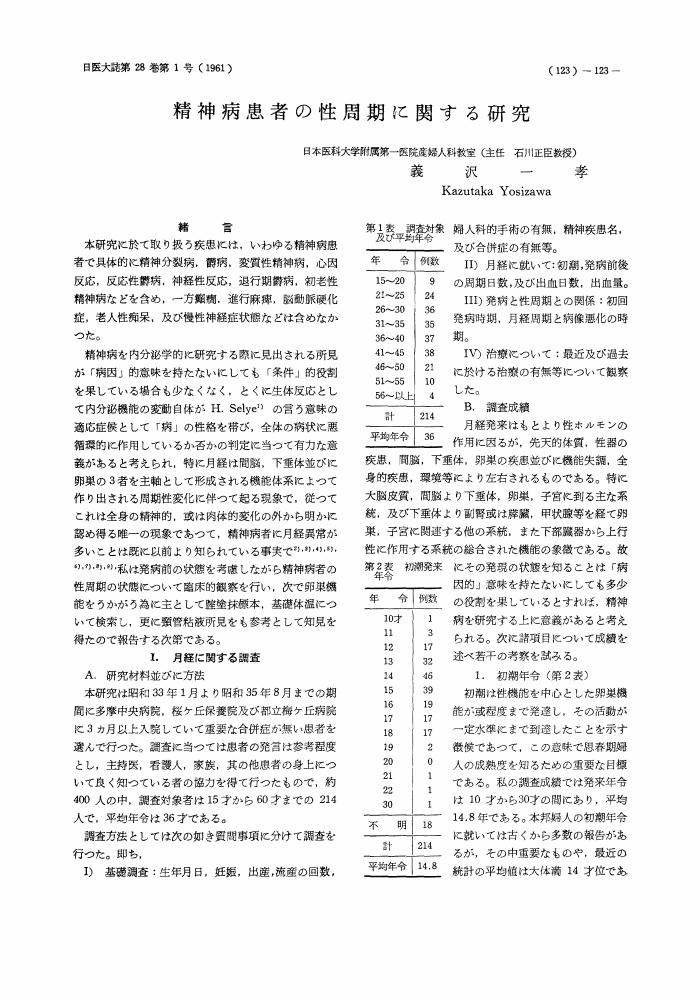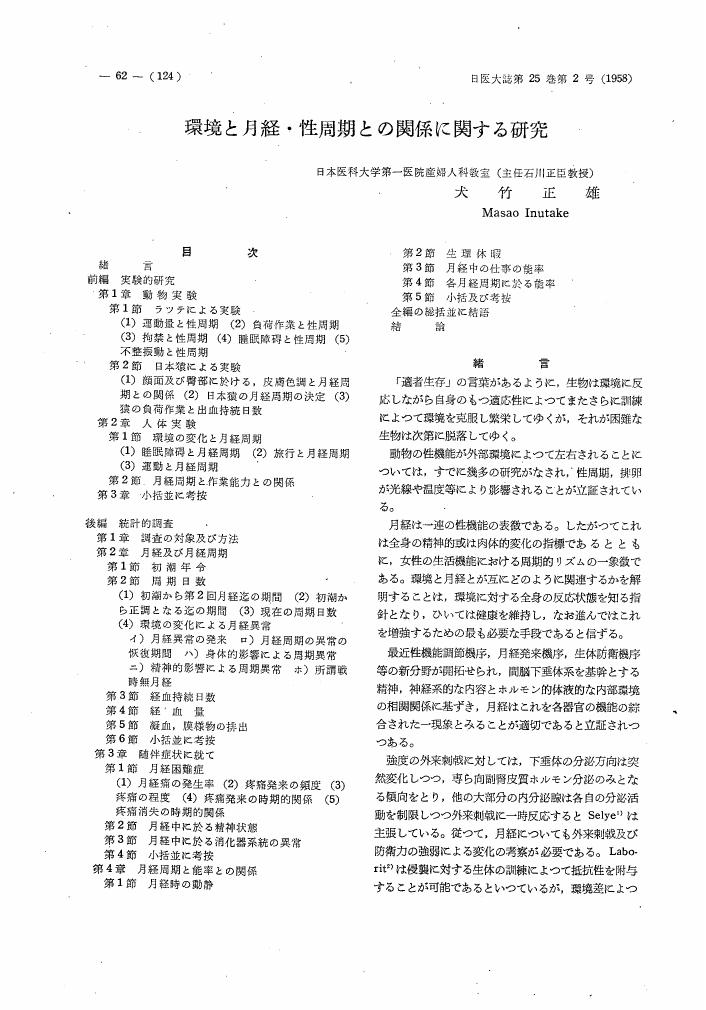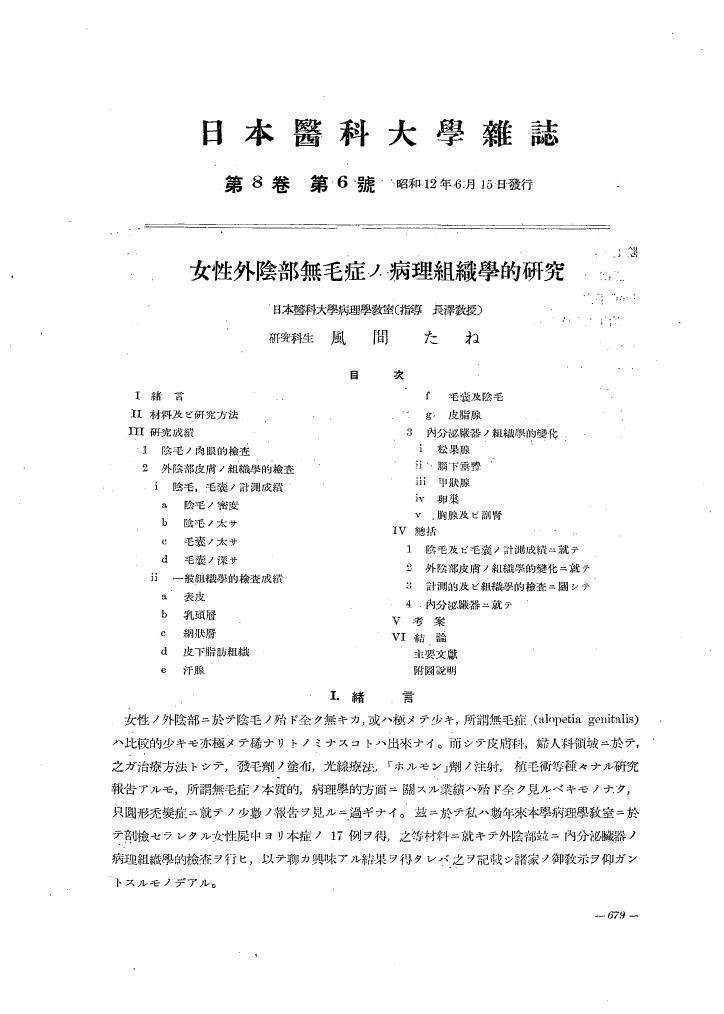1 0 0 0 OA 精神病患者の性周期に関する研究
- 著者
- 義沢 一孝
- 出版者
- 日本医科大学医学会
- 雑誌
- 日本医科大学雑誌 (ISSN:00480444)
- 巻号頁・発行日
- vol.28, no.1, pp.123-134, 1961-01-15 (Released:2010-10-14)
- 参考文献数
- 64
1 0 0 0 OA 環境と月経・性周期との関係に関する研究
- 著者
- 犬竹 正雄
- 出版者
- 日本医科大学医学会
- 雑誌
- 日本医科大学雑誌 (ISSN:00480444)
- 巻号頁・発行日
- vol.25, no.2, pp.124-144, 1958-02-15 (Released:2009-07-10)
- 参考文献数
- 43
1 0 0 0 所謂「馬乗り」遊戯中に起つた下腿骨折に就て
- 著者
- 中西 修
- 出版者
- The Medical Association of Nippon Medical School
- 雑誌
- 日本医科大学雑誌 (ISSN:00480444)
- 巻号頁・発行日
- vol.20, no.6, pp.566-569, 1953
1 0 0 0 OA 人胎児上肢原基の発生学的研究
- 著者
- 都築 茂
- 出版者
- 日本医科大学医学会
- 雑誌
- 日本医科大学雑誌 (ISSN:00480444)
- 巻号頁・発行日
- vol.24, no.3, pp.183-205, 1957-03-15 (Released:2009-07-10)
- 参考文献数
- 22
After Streeter begins the human arm in his horizon XIII to develop. The author's investigation begins from the. Streeter's horizon XIV upward. The author's to the youngest horizon belonging human embryo is 7 mm long which arm is only the mass of simple homogenous mesenchymal tissue, the nerve plate consisting of from the 4 th to the 8th cervical and the first thoracal nerves is protruding in the basic part of this appendage (plate 1). This nerve plate is the anlage of the brachial plexus and is beginning to divide into ventral and dorsal parts. This condition is almost the same in the next to the horizon XV belonging 6 mm long embryo, in which the central tissue of the arm is a little different from the surrounding more condensed tissue (plate 1). This central tissue may be called the beginning of the praecartilageous. The praecartilageous tissue is observed in the next to the horizon XVI belonging 9 mm long embryo, the cartilageous in the 9.5 mm long, which belongs to the Streeter's horizon XVII.The brachial plexus, which divides into ventrocranial and dorsocaudal portions without any prolongation of the branches in the 6 mm long embryo, is in the next 9 mm long well developed so that all the branches of the plexus are distinguished.In the next stage are all branches of the plexus brachialis prolonged and distinct, the precartilageous tissue of the axis of the arm is becoming cartilageous. The chondrification of the skeleton is observable in the scapula, humerus, radius, ulna and in a few carpal bones, the others yet precartilageous.A. axillaris of the 6 mm long embryo divides into A. brachialis and profunda brachii, in the 9 min long thus divided A. brachialis is prolonged to become A. interossea. The distal branch of the interossea reaches the hand plate, where it terminates as the dorsal and volar interossea. This form of the arterial branches is also in the next 9.5 mm long embryo observed, in which A. mediana from the brachialis communicates with the volar interossea.As for the venous system of the arm of these human embryos, there is no distinct change of form. The socalled Randvene or primary ulnae vein of the early stages is observed through three horizons XV, XVI, XVII, almost the same. The cranial end of the vein terminates as a venous net at the root of the arm, the caudel prolongation continues to the lateral side of the brachial plexus where it ascends and bends medialward to pour into the anterior cardinal vein.
1 0 0 0 OA 速読者の脳波FFT解析による読書についての考察
- 著者
- 横山 聡
- 出版者
- 日本医科大学医学会
- 雑誌
- 日本医科大学雑誌 (ISSN:00480444)
- 巻号頁・発行日
- vol.59, no.3, pp.234-246, 1992-06-15 (Released:2010-10-14)
- 参考文献数
- 17
- 被引用文献数
- 2 2
Fast Fourier Transform (FFT) analysis method. The subjects who had mastered a “rapid-reading” method, were classified into two groups according to theirrapid-reading achievement level: the “under-trained readers” (male 5, female 2) had already acquired the ability of smooth eye movement, but continued to use the mental phonetic process while reading. The “well-trained readers” (male 6, female 2) could understand the contents of the text without resorting to such phonetic process. All subjects were righthanded.The tasks were designed to eliminate the artifact of the eye movement and the electromyogram as much as possible. The EEGs were recorded with twelve channels of the international standard 10-20 electrode system. The relative power value (R. P. V.) was calculated as follows:RPV (%) = {(X. C) IN} X 100(%)where X is the beta 1 or beta 2 power value by FFT analysis while doing tasks, C is the power value while doing control tasks, and N is the value in the resting state with the eyes open. The results were statistically analyzed by paired I-test.The following results were obtained: In both groups; (a) the left angular gyrus was usually activate during the rapid-reading; (b) the Wernicke's center was activated only during reading with the phonetic process; (c) in the well-trained readers the activation of the right visual cortex was associated with some visual imaging during the rapid-reading; (d) in the under-trained readers, the association between the activation of the central frontal area and the rapid-reading was observed.Thus, the following model for “reading” was obtained: Two parallel pathways seem important in the processing of the verbal information presented visually; one relates only to the left angular gyrus where the visual-verbal information is processed directly, and the other relates to the interactive pathway between the left angula gyrus and the Wernicke's center. Moreover, the visual cortex of the non-verbal hemisphere seems to play some role in understanding verbal information.
1 0 0 0 OA ヘリコバクター・ピロリと消化性潰瘍および胃癌
1 0 0 0 OA めまい患者における血清電解質変動とその意義
- 著者
- 木村 俊三
- 出版者
- 日本医科大学医学会
- 雑誌
- 日本医科大学雑誌 (ISSN:00480444)
- 巻号頁・発行日
- vol.35, no.1, pp.17-25, 1968-02-15 (Released:2010-10-14)
- 参考文献数
- 62
1 0 0 0 OA 女性外陰部無毛症ノ病理組織学的研究
- 著者
- 風間 たね
- 出版者
- 日本医科大学医学会
- 雑誌
- 日本医科大学雑誌 (ISSN:00480444)
- 巻号頁・発行日
- vol.8, no.6, pp.679-720_2, 1937-06-15 (Released:2009-12-04)
- 参考文献数
- 40
1 0 0 0 OA 産科因子と出産児の遠隔的障害
1 0 0 0 OA 犯罪者屍腦髓ノ細胞構成學的研究
1 0 0 0 OA 狭心症および心筋梗塞患者の予後に及ぼす無症候性心筋虚血の臨床的意義
- 著者
- 斉藤 勉
- 出版者
- 日本医科大学医学会
- 雑誌
- 日本医科大学雑誌 (ISSN:00480444)
- 巻号頁・発行日
- vol.58, no.1, pp.74-85, 1991-02-15 (Released:2010-12-22)
- 参考文献数
- 50
内科的治療により胸痛発作が認められないST下降型狭心症93例と心筋梗塞160例の長期予後とその規定因子について, ホルター心電図, トレッドミル運動負荷試験成績および冠動脈造影所見を用い生命表法とCox型重回帰分析法にて解析し, ホルター心電図にて検出されたsilent myocardial ischemiaの臨床的および予後的意義を検討した結果, 以下の成績を得た.1) 狭心症および心筋梗塞群における心事故発生率はそれぞれ19%, 18%であり, 有意な予後規定因子は狭心症群にて多枝病変, asynergy, silent myocardialischemia, 運動負荷試験によるST下降の順であり, 心筋梗塞群ではsilent myocardial ischemia, 多枝病変の順で両群ともに, 多枝病変とsilent myocardialischemiaが独立した予後規定因子であった.2) Silent myocardial ischemiaを有する狭心症および心筋梗塞の頻度はそれぞれ30%, 38%であり, 諸家の報告とほぼ同頻度であった.3) 心事故発生率は狭心症, 心筋梗塞群ともにsilentmyocardial ischemia非出現群に比し出現群で高く, 心筋梗塞群では有意であった. また, その内訳は狭心症群では冠血行再建術が最も多く, 心筋梗塞群では再梗塞が多かった.4) Silent myocardial ischemia出現群の予後規定因子は狭心症群では多枝障害, 運動時間の短縮, asynergyの存在, 運動負荷試験による狭心症出現であるのに対し, 心筋梗塞群では左室駆出分画の低下, ホルター心電図における最大ST下降度であった.以上より, silent myocardial ischemiaは冠動脈疾患における心事故発生の重要な規定因子であり, silentmyocardial ischemia出現例の心事故発生率は非出現例に比し高かった. 心事故の内訳は狭心症群では冠血行再建術施行例が多く重症な合併症は少なかったのに対し, 心筋梗塞群では再梗塞が多く予後は不良であった. したがって, 心筋梗塞群では症状の有無にかかわらずSMI例に対し早期から積極的に冠血行再建術を施行すべきであると考える. 一方, SMI出現例における予後規定因子は心筋梗塞の既往の有無により異なることが明らかにされ, 治療対策上十分留意すべきであると結論される.
1 0 0 0 OA 膣トリコモナスの感染径路の考察
1 0 0 0 OA 日本人脳の月状溝に就いて
- 著者
- 福尾 勉
- 出版者
- 日本医科大学医学会
- 雑誌
- 日本医科大学雑誌 (ISSN:00480444)
- 巻号頁・発行日
- vol.27, no.2, pp.294-323, 1960-02-15 (Released:2010-10-14)
- 参考文献数
- 26
1. The lunate sulcus is present in 69 Japanese brains among 90, in 101 hemispheres among 180; the percentage is 76.7 for individuals, 56.1 for hemispheres.2. As for the side of the appearance of the lunate, the left side (25 among 90 individuals, 27.7%) is far more frequent than the right (12, 13.3%). Among 101 hemispheres with the lunate sulcus 57 are left (56.4%), 44 are right (43.5%) As for the sexual difference the lunate sulcus is present more frequent in the female brain (17 among 24 hemispheres, 70.8%).3. The site of the lunate sulcus is on the same hight with the occipital pole (66.3%), when it deviates, it is more frequent lower (28.7 %) than higher (5.4%).4. The form of the lunate sulcus is almost half circle in 50.4%(type I-V), the others (type VI-XI) are more flat or bent down, the chord of the arc runs almost always from up and medial to down lateral.5. The greatest distance from the occipital pol to the lunate sulcus is 2.6-3.5cm long in total, it is longer (3.1-3.5cm) by the half circle form, shorter (2.6-3.0cm) by the flat form.6. The depth of the lunate sulcus is pretty deep, it's length is 3.1-5.0cm.7. The situations of the lunate sulcus is up and lateral to the outer part of the retrocalcarine sulcus, except this retrocalcarine the upper and lower occipital sulci are surrounded by the arc of the lunate. A part of the upper occipital may situate out of the arc, the lateral occipital comes always lateral and out of the lunate.8. The retrocalcarine sulcus is present in 135 among 180 hemispheres, its prolongation to the lateral side is observed in 88 among 135. The lunate sulcus comes in 61 among these 88, the remaining 40 hemispheres with the lunate are without retrocalcarine.9. As for the anastomosing sulcus with lunate the upper occipital is more frequent than the lower occipital. The number of the anastomose is one in 45.5% among lunate hemispheres. The site of the anastomose is at the middle part of the sulcus, less frequent at the lower end and scanty at the upper end.10. The lunate sulcus is almost always accompanied by the prelunate, , the number of the latter is one, less frequently two. Except this prelunate there are 2 or 3 collateral short accompanying sulci.11. The dimensions of the cuneus on the medial surface are inclined to be a little broader by the lunate specimens. The angles between the calcarine and parieto-occipital sulci oscilate between 70° and 89°. It seems that there is no correlative relation between this angle and lunate.12. By the lunate specimens are the intraparietal sulci not straight and run nearer to the mantle rim. At their caudal end the medial branch of the transverse occipital sulcus is longer than the lateral.13. When a circumscript elevation on the outer surface of the occipital lobe may be called as operculum, there are 126 examples among 180 hemispheres. In the 101 lunate specimens there are 55 distinct, 24 not so much distinct operculum, 79 in total.14. The sulci which limit the operculum at the upper margin are almost always the transverse occipital, at the lateral margin are the lunate, and when the latter deficient the lateral occipital.15. The lateral occipital sulcus is distinct in 168 among 180 hemispheres, and when the lunate is present it lies always medial to the lateral occipital and horizontal. The anastmosis with the lateral occipital comes to the temporalis medius frequently (62 among 180).16. The upper and lower occipital sulci are less marked by the lunate brains.
1 0 0 0 OA 低気圧環境に対する生体反応に関する実験的研究
- 著者
- 李 鍾酷
- 出版者
- 日本医科大学医学会
- 雑誌
- 日本医科大学雑誌 (ISSN:00480444)
- 巻号頁・発行日
- vol.26, no.11, pp.1173-1185, 1959-11-15 (Released:2010-10-14)
- 参考文献数
- 75
Experiments have been done on the vital reactions in acute and chronic exposure to the lowered barometric pressure using rabbits and high altitude chamber, and new approaches were undertaken for the elucidation of the mechanism of altitude adaptation from the analyses of blood viscosity and plasma proteins using 8 female rabbits exposed to 18, 000 feet for nine weeks.Those findings in acute and chronic hypoxci hypoxia were sammarized in Table 21. Shortly speaking, in acute hypoxia the organism can reveal its homeostatic mechanism through only physical method (i.e. hyperpnea), and on the contrary, for biological or chemical adaptation, it takes considerable time.Hypoxic respiratory acidosis is different from normoxic respiratory acidosis in its reduced CO2-combining capacity.In chronic hypoxia, namely, acclimatization to 18, 000 feet for nine weeks, hemoglobin concentration, hematocrit, circulating blood volume, circu lating plasma volume, and cell volume increased 20, 23, 78, 36 and 116%, respectively. Plasma protein amount increased about 33 Albumin-globulin ratio was elevated, but serum γ-globulin decreased.In short, the vital responses in acclimatization to hypoxia is the increase of oxygen carrying capacity due to increased circulating hemoglobin. This increase was accomplished by the increase of erythrocytes. However, when hematocrit increa ses over 60%, blood viscosity becomes very high and consequently circulatory disturbances result. The organism prevents increase in hematocrit by increasing circulating blood volume to minimize such disturbances. In reality, the circulating hemoglobin amount increased to twice normal. In order to prevent high hematocrit, plasma volume also increased. To compensate for increased blood viscosity due to somewhat increased hematocrit, plasma viscosity was lowered by decreased plasma protein concentration and higher albumin-globulin ratio. Moreover, nutritional disturbances and the plasma colloid osmotic pressure functions were completely compensated by increased total circulating plasma protein amount and by relative increase of the albumin fraction.Reasonable and physiologic compensatory vital functions of the organism were shown in these phenomena exhibited by the acclimatized animals.







